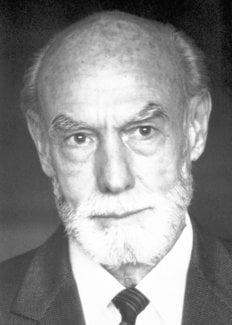Roger W. Sperry
Biographical
 Birthplace and Family: Born August 20, 1913, in Hartford, Connecticut to Francis Bushnell and Florence Kraemer Sperry of Elmwood, a small suburb. Father was in banking; mother trained in business school and after dad’s death, when I was 11 years old, she became assistant to the principal in the local high school. One brother, Russell Loomis, a year younger, went into chemistry. I was married to Norma Gay Deupree, December 28, 1949. We have one son, Glenn Michael (Tad), born October 13, 1953 and one daughter, Janeth Hope, born August 18, 1963.
Birthplace and Family: Born August 20, 1913, in Hartford, Connecticut to Francis Bushnell and Florence Kraemer Sperry of Elmwood, a small suburb. Father was in banking; mother trained in business school and after dad’s death, when I was 11 years old, she became assistant to the principal in the local high school. One brother, Russell Loomis, a year younger, went into chemistry. I was married to Norma Gay Deupree, December 28, 1949. We have one son, Glenn Michael (Tad), born October 13, 1953 and one daughter, Janeth Hope, born August 18, 1963.
Education: My early schooling was in Elmwood, Connecticut and William Hall High School in West Hartford, Connecticut. I attended Oberlin College on a 4 year Amos C. Miller Scholarship. After receiving the AB in English in 1935, I stayed on 2 years more in Oberlin for an MA in Psychology, 1937, under Professor R. H. Stetson. I then took an additional third year at-large at Oberlin to prepare for a switch to Zoology for Ph.D. work under Professor Paul A. Weiss at the University of Chicago. After receiving the Ph.D. at Chicago in 1941, I did a year of postdoctoral research as a National Research Council Fellow at Harvard University under Professor Karl S. Lashley.
Professional positions: Biology research fellow, Harvard University, at Yerkes Laboratories of Primate Biology (1942-46); Assistant professor, Department of Anatomy, University of Chicago (1946-52); Associate professor of psychology, University of Chicago (1952-53); Section Chief, Neurological Diseases and Blindness, National Institutes of Health (1952-53); Hixon professor of psychobiology, California Institute of Technology (1954-present).
Awards and Honors: Amos C. Miller Scholarship, Oberlin College (1931-35); National Research Council Fellowship (1941-42); Distinguished Alumni Citation; Oberlin College (1954); Elected National Academy of Sciences (1960); Elected American Academy of Arts and Sciences (1963); Howard Crosby Warren Medal, Society of Experimental Psychologists (1969); Distinguished Scientific Contribution Award, American Psychological Association (1971); California Scientist of the Year Award (1972); Co-recipient William Thomson Wakeman Research Award, National Paraplegia Foundation (1972); Honorary Doctor of Science degree, Cambridge University (1972); Passano Award in Medical Science (1973); Elected American Philosophical Society (1974); Elected Honorary Member American Neurological Association (1974); Co-recipient Claude Bernard Science Journalism Award (1975); Karl Lashley Award of American Philosophical Society (1976); Elected Foreign Member of Royal Society (1976); Honorary Doctor of Science Degree, University of Chicago (1976); Elected member of Pontifical Academy of Sciences (1978); Honorary Doctor of Science Degree, Kenyon College (1979); Wolf Prize in Medicine (1979); Ralph Gerard Award of the Society of Neurosciences (1979); International Visual Literacy Association Special Award (1979); Albert Lasker Medical Research Award (1979); Honorary Doctor of Science Degree, The Rockefeller University (1980); American Academy of Achievement Golden Plate Award (1980)
A vocational and anti-brain-strain: Collected and raised large American moths in grade school. Ran trap line and collected live wild pets during junior high school years. Three-letter man in varsity athletics in high school and college. Through middle life continued evening and weekend diversionary activities including sculpture, ceramics, figure drawing, sports, American folk dance, boating, fishing, snorkeling, water colors, and collecting unusual fossils – among which we have a contender for the world’s 3rd largest ammonite.
Selected Bibliography
- The problem of central nervous reorganization after nerve regeneration and muscle transposition. R.W. Sperry. Quart. Rev. Biol. 20:311-369 (1945).
- Regulative factors in the orderly growth of neural circuits. R.W. Sperry. Growth Symp. 10: 63-67 (1951).
- Cerebral organization and behavior. R.W. Sperry. Science 133:1749-1757 (1961).
- Chemoaffinity in the orderly growth of nerve fiber patterns and connections. R.W. Sperry. Proc. Nat. Acad. Sci. USA 50: 703-710 (1963).
- Interhemispheric relationships: the neocortical commissures; syndromes of hemisphere disconnection. R.W. Sperry, M.S. Gazzaniga, and J.E. Bogen. In Handbook Clin. Neurol. P. J. Vinken and G.W. Bruyn (Eds.), Amsterdam: North-Holland Publishing Co. 4: 273-290 (1969).
- Lateral specialization in the surgically separated hemispheres. R.W. Sperry. In Neurosciences Third Study Program. F. Schmitt and F. Worden (Eds.), Cambridge: MIT Press 3:5-19 (1974).
- Mind-brain interaction: mentalism, yes; dualism, no. R.W. Sperry. Neuroscience 5: 195-206 (1980). Reprinted in Commentaries in the Neurosciences. A.D. Smith, R. Llanas and P.G. Kostyuk (Eds.), Oxford: Pergamon Press, pp. 651-662 (1980).
- Science and moral priority: merging mind, brain and human values. R.W. Sperry. Vol. 4 of Convergence, (Ser. ed. Ruth Anshen) New York: Columbia University Press (1982).
This autobiography/biography was written at the time of the award and later published in the book series Les Prix Nobel/ Nobel Lectures/The Nobel Prizes. The information is sometimes updated with an addendum submitted by the Laureate.
Roger W. Sperry died on April 17, 1994.
Nobel Prizes and laureates
Six prizes were awarded for achievements that have conferred the greatest benefit to humankind. The 12 laureates' work and discoveries range from proteins' structures and machine learning to fighting for a world free of nuclear weapons.
See them all presented here.
